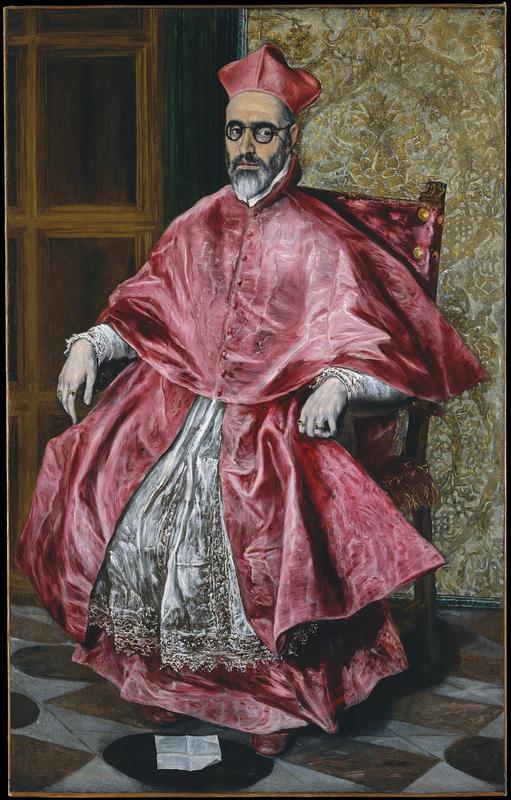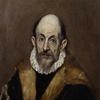More about Cardinal Fernando Niño de Guevara

Sr. Contributor
If you’ve ever wondered how powerhouse museums like the Met acquired masterpieces by El Greco, you can thank rich families and their glorious, old New York money.
Henry Osborne Havemeyer and his wife Louisine were filthy rich New Yorkers with a penchant for purchasing the best paintings the international art market had to offer. After making a fortune through an unscrupulous sugar business based in Brooklyn, the Havemeyers’ money knew no bounds. They’re famously remembered for giving an astounding 2,000 works to the Met from a legendary bequest in 1929. Among the works were their fabulous collection of Impressionists, an arresting portrait by Bronzino, the largest American collection of Courbet nudes, and Spanish superstars including El Greco and Goya.
The Havemeyers could afford the best art, as well as the best assistance in purchasing it. Mary Cassatt was both a family friend and art advisor who helped steer the couple in the right direction. No big deal. Despite enlisting Cassatt’s help, the Havemeyers bought art with a voracious appetite that sometimes cost them. Of the sixteen Goyas they purchased, only four were real. With regard to El Greco, Cassatt’s trained eye came in handy. She was the first person to recommend that the couple purchase the arresting portrait of Cardinal Fernando Niño de Guevara. The Havemeyers already owned View of Toledo, so why not add more?
At first, H.O. Havemeyer wasn’t interested in the painting. If you can believe it, he didn’t like the Cardinal’s eyeglasses, which is clearly a dealbreaker. Havemeyer eventually got over the Cardinal’s four eyes and spent an agonizing four years trying to get the painting out of Spain, where it had been in the same family since the time of its creation about 300 years earlier. If you want a better idea of how annoyingly rich the Havemeyers were, here’s a fun anecdote: As the Havemeyers became more interested in purchasing even more priceless works by El Greco, they had the opportunity to purchase Fray Hortensio Felix Paravicino. Havemeyer kept his sights on the portrait of the Cardinal, though, because according to him, why would anyone want a monk when you could have a cardinal? What a sweetie.
Perhaps it was El Greco’s depiction of the Cardinal’s intense power that allured Havemeyer. As a Cardinal, Fernando Niño de Guevara was powerful, but he had unparalleled power during his two-year reign as Inquisitor General under Philip III. During the Spanish Inquisition, the Inquisitor General was the most powerful ecclesiastic in Spain. Inquisitor Generals traveled around and announce their arrival in each town, giving potential heretics a chance to turn themselves in. Those who gave themselves up suffered more mild punishments than those who were found guilty without admitting their heresies. Inquisitors ordered these people executed.
Guevara was a particularly ruthless Inquisitor General, and this portrait was probably painted while he was on official Inquisition business in Toledo. During this visit, he declared that forty-six people were to be executed. Guevara deemed one man so totally beyond redemption that he ordered the man be taken away and burned on the spot. Yikes.
Sources
- Baetjer, Katharine. “El Greco.” The Metropolitan Museum of Art Bulletin. Volume 39, Number 1. Summer 1981.
- Frelinghuysen, Alice Cooney, Gary Tinterow, Susan Alyson Stein, Gretchen Wold, and Julia Meech, Splendid Legacy: The Havemeyer Collection. New York: The Metropolitan Museum of Art, 1993.
- History.com. “Inquisition.” https://www.history.com/topics/inquisition. Accessed June 12, 2018.
- Kimmelman, Michael. “Review/Art; Havemeyer Collection: Magic at the Met Museum.” The New York Times. March 26, 1993. https://www.nytimes.com/1993/03/26/arts/review-art-havemeyer-collection…. Accessed June 12, 2018.
- The Metropolitan Museum of Art. “Cardinal Fernando Nino de Guevara (1541-1609).” Collection. https://www.metmuseum.org/art/collection/search/436573. Accessed June 12, 2018.
Featured Content
Here is what Wikipedia says about Portrait of Fernando Niño de Guevara
Portrait of Fernando Niño de Guevara is a 1600 painting of cardinal Fernando Niño de Guevara by El Greco, now in the Metropolitan Museum of Art in New York.
In the article, “Three Paintings by El Greco,” Walter Liedtke theorizes that it was the nephew of Cardinal Guevara, Pedro Lasso, who commissioned his portrait. In Spain during this time it was a novelty to commission a portrait on one's self (outside of courtiers), therefore it is most likely a family member who commissioned this portrait. Conde de Los Arcos (Pedro Lasso), was an established patron of El Greco at the time when this portrait was commissioned. Lasso was a prominent member of the Spanish court and one of the only titled noble members among El Greco's group of friends and acquaintances. At the time of Lasso's death, he is said to have owned seven or eight El Greco paintings, although it is unclear whether the portrait of Cardinal Fernando Nino de Guevara was among this group.
The commission of this painting likely occurred in the spring of 1600, when the Cardinal visiting Toledo for several weeks. As Katharine Baetjer notes, Guevara was named cardinal of San Martino ai Monti in 1596 and thereafter traveled to Rome. In 1599, the Cardinal then received a nomination and subsequent promotion to Inquisitor General of Spain, and made a trip to Toledo. It is possible that, during the Cardinal's visit to Toledo, Conde de Los Arcos may have recommended El Greco to his uncle. Although Guevara had siblings who could have commissioned his portrait, during this time, his sisters were dedicated to various convents and his brother, Rodrigo, lived primarily in the Spanish Netherlands and was likely not in Spain often enough to know the prominence and popularity of the work of El Greco.
This portrait may have served as a celebration of family pride. Liedtke also notes that, “among the many works of art that Pedro Lasso collected and commissioned were family portraits and portraits of public figures, including famous churchmen and Spanish royalty.” Pedro Lasso may have used this commissions portrait of his uncle as a ‘public gesture,’ and placed it in a “residence, family chapel, or an institution such as a church that he was known to support.” If this portrait was hung in a public space, it would serve two purposes which elevated the family's status, having a prominent member of the church as a relative, and having a well-known artist (who by this time has received at least one commission for King Philip II) paint the portrait.
The painting of the portrait was fictionalised in the 1936 novel El Greco malt den Großinquisitor by Stefan Andres.
In the 1947 film Lady in Ermine, the inquisitor (Rafael Calvo) sits for his portrait and judges a trial involving a Jewish silversmith in love with El Greco's (fictional) daughter.
The 2007 film El Greco (directed by Yannis Smaragdis) includes a fictional incident of the cardinal (played by Juan Diego Botto) trying El Greco before the Inquisition.
Check out the full Wikipedia article about Portrait of Fernando Niño de Guevara












